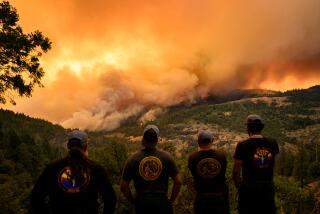New Factors Threaten Life of Small, Endangered Fish
A tiny, endangered fish found in the Santa Clarita Valley, which is besieged by development and natural predators, is facing two more threats that could hasten its extinction.
Biologists fear the fifth year of severe drought, combined with the recent spill of 75,000 gallons of crude oil into the Santa Clara River, could destroy the shrinking habitat of the unarmored three-spined stickleback. Biologists believe the Santa Clarita Valley may be the dwindling stickleback’s last refuge.
“This may be all we have left,” said Jonathan Baskin, a Cal Poly Pomona biology professor, as he surveyed a pristine pool filled with sticklebacks a few miles east of Santa Clarita Thursday afternoon.
Despite the drought, the pool was lush, and the sticklebacks netted by Baskin and three colleagues who sloshed through the water appeared healthy and ready to enter the mating season. Tom Haglund, a UCLA research biologist, held up a male stickleback, pointing out its bright blue eyes and glowing red throat.
“The males get a very distinctive reproductive color,” Haglund said.
But the outlook for the stickleback is not so rosy elsewhere in the Santa Clara River and its tributaries, the last strongholds of a fish once found in abundant numbers in the Los Angeles and Santa Ana rivers. The stickleback was placed on the endangered species list in the mid-1970s.
Some ponds in Soledad Canyon, where the biologists worked Thursday, have shrunk with the drought. Soledad Canyon also is home to African clawed frogs, which are decimating the stickleback population. Baskin speculated that the frogs are descendants of escaped lab animals or aquarium pets released by owners.
Another stickleback habitat in a canyon to the north is being destroyed by arundo, a bamboo-like exotic plant which clogs the shallow streams preferred by sticklebacks.
The third remaining habitat is on the western end of Santa Clarita, where the Santa Clara River passes underneath the Golden State Freeway near Magic Mountain. On Jan. 31, an aging underground oil pipeline ruptured there, sending black goo into the river bed.
Almost 200 birds and animals have died as a result of the spill. While the impact of the oil on the stickleback is unclear, Baskin said he is worried.
Baskin and Haglund are hopeful that they may be able to relocate sticklebacks, which will be taken this spring to the Santa Ana River in San Bernardino County. The researchers have secured about $12,000 from the state Department of Fish and Game for the move but still need the approval of the U.S. Wildlife Service.
More to Read
Sign up for Essential California
The most important California stories and recommendations in your inbox every morning.
You may occasionally receive promotional content from the Los Angeles Times.










